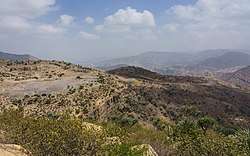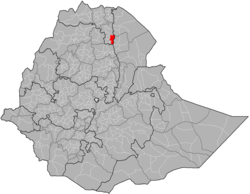Raya Azebo
Raya Azebo (Tigrinya: ራያ ዓዘቦ) is one of the woredas in the Tigray Region of Ethiopia. Located in the Debubawi Zone at the eastern edge of the Ethiopian highlands, Raya Azebo is part of the Southern Tigray Region. The administrative center of this woreda is Mekoni. Other towns in Raya Azebo include Weyra Wuha, Chercher, Adi Abdera, Kukufto, Bala and Hade Alga.
Raya Azebo ራያ ዓዘቦ | |
|---|---|
 | |
 Flag | |
 | |
| Region | Tigray |
| Zone | Debubawi (Southern) |
| Area | |
| • Total | 2,132.83 km2 (823.49 sq mi) |
| Population (2007) | |
| • Total | 135,870 |
Demographics
Based on the 2007 national census conducted by the Central Statistical Agency of Ethiopia (CSA), this woreda has a total population of 135,870, an increase of 55.04% over the 1994 census, of whom 67,687 are men and 68,183 women; 16,056 or 11.82% are urban inhabitants. With an area of 2,132.83 square kilometers, Raya Azebo has a population density of 63.70, which is greater than the Zone average of 53.91 persons per square kilometer. A total of 32,360 households were counted in this woreda, resulting in an average of 4.20 persons to a household, and 31,468 housing units. 70.61% of the population said they were Orthodox Christians, and 29.32% were Muslim.[1]
The 1994 national census reported a total population for this woreda of 87,638 of whom 43,259 were men and 44,379 were women; 8,047 or 9.18% of its population were urban dwellers. The four largest ethnic groups reported in Raya Azebo were the Tigrayans (87.21%), the Amhara (9.77%), the Afar (1.55%), and the Oromo (1.4%); all other ethnic groups made up 0.07% of the population. Tigrinya was spoken as a first language by 85.52%, 11.04% Amharic, 1.83% Oromo, and 1.53% spoke Afar; the remaining 0.08% spoke all other primary languages reported. 69.15% of the population practiced Ethiopian Orthodox Christianity, and 30.82% were Muslim. Concerning education, 8.44% of the population were considered literate, which is less than the Zone average of 15.71%; 14.64% of children aged 7–12 were in primary school; 0.9% of the children aged 13–14 were in junior secondary school; and 0.31% of the inhabitants aged 15–18 were in senior secondary school. Concerning sanitary conditions, 56.9% of the urban houses and 13.4% of all houses had access to safe drinking water at the time of the census; 20.6% of the urban and about 4.7% of the total had toilet facilities.[2]
References
- Census 2007 Tables: Tigray Region, Tables 2.1, 3.1, 3.2, 3.4.
- 1994 Population and Housing Census of Ethiopia: Results for Southern Nations, Nationalities and Peoples' Region, Vol. 1, part 1, Tables 2.1, 2.12, 2.19, 3.5, 3.7, 6.3, 6.11, 6.13 (accessed 30 December 2008)